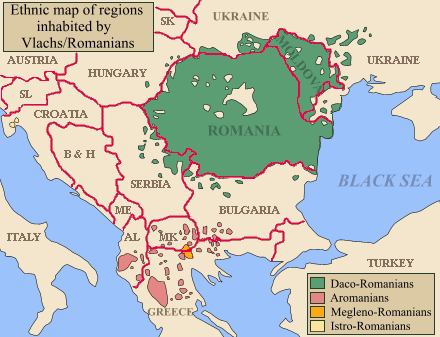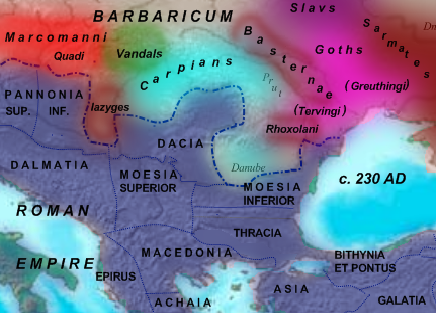|
Re-latinization Of Romanian
The re-latinization of Romanian (also known as re-romanization) was the reinforcement of the Romance features of the Romanian language during the 18th and 19th centuries. In this period, Romanian adopted a Latin-based alphabet to replace the Cyrillic script and borrowed many words from French as well as from Latin and Italian, in order to acquire the lexical tools necessary for modernization. This process coined words for recently introduced objects or concepts (neologisms), added Latinate synonyms for some Slavic and other loanwords, and strengthened some Romance syntactic features. Some linguistic research emphasize that the use of this term is inappropriate as it conflates the larger process of modernization of the language with the more extreme, and in the end unsuccessful, current of eliminating non-Latin influences, and, secondly, the term's lack of precision is susceptible to lead to confusion as the Latin character of the Romanian language had already been noticed since at ... [...More Info...] [...Related Items...] OR: [Wikipedia] [Google] [Baidu] |
Romance Languages
The Romance languages, sometimes referred to as Latin languages or Neo-Latin languages, are the various modern languages that evolved from Vulgar Latin. They are the only extant subgroup of the Italic languages in the Indo-European language family. The five most widely spoken Romance languages by number of native speakers are Spanish (489 million), Portuguese (283 million), French (77 million), Italian (67 million) and Romanian (24 million), which are all national languages of their respective countries of origin. By most measures, Sardinian and Italian are the least divergent from Latin, while French has changed the most. However, all Romance languages are closer to each other than to classical Latin. There are more than 900 million native speakers of Romance languages found worldwide, mainly in the Americas, Europe, and parts of Africa. The major Romance languages also have many non-native speakers and are in widespread use as linguae francae.M. Paul Lewis,Summary by l ... [...More Info...] [...Related Items...] OR: [Wikipedia] [Google] [Baidu] |
Transylvania
Transylvania ( ro, Ardeal or ; hu, Erdély; german: Siebenbürgen) is a historical and cultural region in Central Europe, encompassing central Romania. To the east and south its natural border is the Carpathian Mountains, and to the west the Apuseni Mountains. Broader definitions of Transylvania also include the western and northwestern Romanian regions of Crișana and Maramureș, and occasionally Banat. Transylvania is known for the scenery of its Carpathian landscape and its rich history. It also contains Romania's second-largest city, Cluj-Napoca, and other iconic cities and towns such as Brașov, Sibiu, Târgu Mureș, Alba Iulia and Sighișoara. It is also the home of some of Romania's List of World Heritage Sites in Romania, UNESCO World Heritage Sites such as the villages with fortified churches in Transylvania, Villages with fortified churches, the Historic Centre of Sighișoara, the Dacian Fortresses of the Orăștie Mountains and the Rosia Montana Mining Cultural Landsc ... [...More Info...] [...Related Items...] OR: [Wikipedia] [Google] [Baidu] |
Albanian–Romanian Linguistic Relationship
The Albanian–Romanian linguistic relationship is a field of the research of the ethnogenesis of both peoples. The common phonological, morphological and syntactical features of the two languages have been studied for more than a century. Both languages are part of the Balkan sprachbund. Aside from Latin, and from shared Greek, Slavic and Turkish elements, other characteristics and words are attributed to the Paleo-Balkan linguistic base: Illyrian, Thracian, Dacian and/or Thraco-Illyrian, Daco-Thracian. Similarities between Romanian and Albanian are not limited to their common Balkan features and the assumed substrate words: the two languages share calques and proverbs, and display analogous phonetic changes. Despite the similarities, genetically they are only distantly related Indo-European languages. Background Romanian Romanian is a Romance language spoken by about 25 million people primarily in Southeastern Europe. Its principal variant, Daco-Romanian, is the ... [...More Info...] [...Related Items...] OR: [Wikipedia] [Google] [Baidu] |
Medieval Greek
Medieval Greek (also known as Middle Greek, Byzantine Greek, or Romaic) is the stage of the Greek language between the end of classical antiquity in the 5th–6th centuries and the end of the Middle Ages, conventionally dated to the Ottoman conquest of Constantinople in 1453. From the 7th century onwards, Greek was the only language of administration and government in the Byzantine Empire. This stage of language is thus described as Byzantine Greek. The study of the Medieval Greek language and literature is a branch of Byzantine studies, the study of the history and culture of the Byzantine Empire. The beginning of Medieval Greek is occasionally dated back to as early as the 4th century, either to 330 AD, when the political centre of the Roman Empire was moved to Constantinople, or to 395 AD, the division of the empire. However, this approach is rather arbitrary as it is more an assumption of political, as opposed to cultural and linguistic, developments. Indeed, by this time ... [...More Info...] [...Related Items...] OR: [Wikipedia] [Google] [Baidu] |
Voiced Alveolar Fricative
The voiced alveolar fricatives are consonantal sounds. The symbol in the International Phonetic Alphabet that represents these sounds depends on whether a sibilant or non-sibilant fricative is being described. * The symbol for the alveolar sibilant is , and the equivalent X-SAMPA symbol is z. The IPA letter is not normally used for dental or postalveolar sibilants in narrow transcription unless modified by a diacritic ( and respectively). * The IPA symbol for the alveolar non-sibilant fricative is derived by means of diacritics; it can be or . Voiced alveolar sibilant The voiced alveolar sibilant is common across European languages, but is relatively uncommon cross-linguistically compared to the voiceless variant. Only about 28% of the world's languages contain a voiced dental or alveolar sibilant. Moreover, 85% of the languages with some form of are languages of Europe, Africa, or Western Asia. Features *There are at least three specific variants of : ** Dentaliz ... [...More Info...] [...Related Items...] OR: [Wikipedia] [Google] [Baidu] |
Dental Consonant
A dental consonant is a consonant articulated with the tongue against the upper teeth, such as , . In some languages, dentals are distinguished from other groups, such as alveolar consonants, in which the tongue contacts the gum ridge. Dental consonants share acoustic similarity and in Latin script are generally written with consistent symbols (e.g. ''t'', ''d'', ''n''). In the International Phonetic Alphabet, the diacritic for dental consonant is . When there is no room under the letter, it may be placed above, using the character , such as in /p͆/. Cross-linguistically For many languages, such as Albanian, Irish and Russian, velarization is generally associated with more dental articulations of coronal consonants. Thus, velarized consonants, such as Albanian , tend to be dental or denti-alveolar, and non-velarized consonants tend to be retracted to an alveolar position. Sanskrit, Hindustani and all other Indo-Aryan languages have an entire set of dental stops that occur p ... [...More Info...] [...Related Items...] OR: [Wikipedia] [Google] [Baidu] |
Palatalization (phonetics)
In phonetics, palatalization (, also ) or palatization is a way of pronouncing a consonant in which part of the tongue is moved close to the hard palate. Consonants pronounced this way are said to be palatalized and are transcribed in the International Phonetic Alphabet by affixing the letter ⟨ʲ⟩ to the base consonant. Palatalization cannot minimally distinguish words in most dialects of English, but it may do so in languages such as Russian, Mandarin, and Irish. Types In technical terms, palatalization refers to the secondary articulation of consonants by which the body of the tongue is raised toward the hard palate and the alveolar ridge during the articulation of the consonant. Such consonants are phonetically palatalized. "Pure" palatalization is a modification to the articulation of a consonant, where the middle of the tongue is raised, and nothing else. It may produce a laminal articulation of otherwise apical consonants such as and . Phonetically palatalized consona ... [...More Info...] [...Related Items...] OR: [Wikipedia] [Google] [Baidu] |
Dacia Trajana
Roman Dacia ( ; also known as Dacia Traiana, ; or Dacia Felix, 'Fertile/Happy Dacia') was a province of the Roman Empire from 106 to 271–275 AD. Its territory consisted of what are now the regions of Oltenia, Transylvania and Banat (today all in Romania, except the last one which is split between Romania, Hungary, and Serbia). During Roman rule, it was organized as an imperial province on the borders of the empire. It is estimated that the population of Roman Dacia ranged from 650,000 to 1,200,000. It was conquered by Trajan (98–117) after two campaigns that devastated the Dacian Kingdom of Decebalus. However, the Romans did not occupy its entirety; Crișana, Maramureș, and most of Moldavia remained under the Free Dacians. After its integration into the empire, Roman Dacia saw constant administrative division. In 119, it was divided into two departments: Dacia Superior ("Upper Dacia") and Dacia Inferior ("Lower Dacia"; later named Dacia Malvensis). Between 124 and aroun ... [...More Info...] [...Related Items...] OR: [Wikipedia] [Google] [Baidu] |
Lower Danube
The Danube ( ; ) is a river that was once a long-standing frontier of the Roman Empire and today connects 10 European countries, running through their territories or being a border. Originating in Germany, the Danube flows southeast for , passing through or bordering Austria, Slovakia, Hungary, Croatia, Serbia, Romania, Bulgaria, Moldova, and Ukraine before draining into the Black Sea. Its drainage basin extends into nine more countries. List of cities and towns on Danube river, The largest cities on the river are Vienna, Budapest, Belgrade and Bratislava, all of which are the capitals of their respective countries; the Danube passes through four capital cities, more than any other river in the world. Five more capital cities lie in the Danube's basin: Bucharest, Sofia, Zagreb, Ljubljana and Sarajevo. The fourth-largest city in its basin is Munich, the capital of Bavaria, standing on the Isar River. The Danube is the List of rivers of Europe#Longest rivers, second-longest riv ... [...More Info...] [...Related Items...] OR: [Wikipedia] [Google] [Baidu] |
Origin Of The Romanians
Several theories address the issue of the origin of the Romanians. The Romanian language descends from the Vulgar Latin dialects spoken in the Roman provinces north of the "Jireček Line" (a proposed notional line separating the predominantly Latin-speaking territories from the Greek-speaking lands in Southeastern Europe) in Late Antiquity. The theory of Daco-Roman continuity argues that the Romanians are mainly descended from the Daco-Romans, a people developing through the cohabitation of the native Dacians and the Roman colonists in the province of Dacia Traiana (primarily in present-day Romania) north of the river Danube. The competing immigrationist theory states that the Romanians' ethnogenesis commenced in the provinces south of the river with Romanized local populations (known as Vlachs in the Middle Ages) spreading through mountain refuges, both south to Greece and north through the Carpathian Mountains. Other theories state that the Romanized local populations were p ... [...More Info...] [...Related Items...] OR: [Wikipedia] [Google] [Baidu] |
Oltenia
Oltenia (, also called Lesser Wallachia in antiquated versions, with the alternative Latin names ''Wallachia Minor'', ''Wallachia Alutana'', ''Wallachia Caesarea'' between 1718 and 1739) is a historical province and geographical region of Romania in western Wallachia. It is situated between the Danube, the Southern Carpathians and the Olt river. History Ancient times Initially inhabited by Dacians, Oltenia was incorporated in the Roman Empire (106, at the end of the Dacian Wars; ''see Roman Dacia''). In 129, during Hadrian's rule, it formed Dacia Inferior, one of the two divisions of the province (together with Dacia Superior, in today's Transylvania); Marcus Aurelius' administrative reform made Oltenia one of the three new divisions (''tres Daciae'') as Dacia Malvensis, its capital and chief city being named Romula. It was colonized with veterans of the Roman legions. The Romans withdrew their administration south of the Danube at the end of the 3rd century and Oltenia wa ... [...More Info...] [...Related Items...] OR: [Wikipedia] [Google] [Baidu] |







